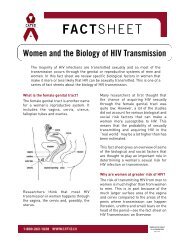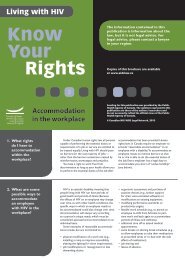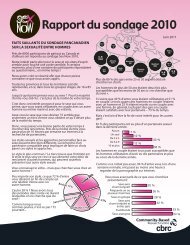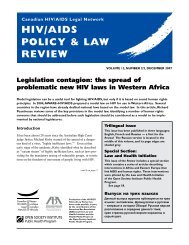leadingtogether: - CATIE
leadingtogether: - CATIE
leadingtogether: - CATIE
- No tags were found...
You also want an ePaper? Increase the reach of your titles
YUMPU automatically turns print PDFs into web optimized ePapers that Google loves.
3.12 Develop plans to support the developmentof new prevention technologies, includingvaccines and microbicides, and to makethem available once they are developed.Surveillance/research/monitoring3.13 Identify standard, consistent data to becollected on HIV in all jurisdictions, andenhance the capacity of the existing HIVsurveillance system to analyze data andprovide timely information and reports toguide prevention programs.3.14 Conduct targeted epidemiologicalsurveillance studies designed to enhanceunderstanding of the factors that contributeto the spread of HIV in affected communities.3.15 Conduct research on effective preventionstrategies for communities vulnerable to HIV,and use the findings to inform preventionprograms.3.16 Monitor the impact of antiretroviraltherapy on children born to women with HIV.3.17 Develop new prevention technologiesbeyond vaccines and microbicides.4.RATIONALESTRENGTHEN DIAGNOSIS,CARE, TREATMENT ANDSUPPORT SERVICESAlthough the quality of HIV care and supportin Canada is among the best in the developedworld, there are still gaps and inconsistencies.Some people – particularly those in rural andremote areas, but also many in marginalizedcommunities in urban centres 88 – still struggleto get the quality care and treatment theyneed. Strengthening diagnosis, care, treatmentand support is directly linked with steppingup prevention efforts.As the needs of people with HIV becomemore complex, services must adapt. Themain challenges in HIV diagnosis, care,treatment and support in Canada in 2004 are:• the significant number of people with HIVwho are not diagnosed until they are in thelater stages of HIV disease and therefore donot have access to appropriate treatment,while managing such complexities such as:• demanding treatment regimens that aredifficult for people with HIV to maintain• the side effects associated with HAART,including cancer, lipodystrophy, heartdisease, neurocognitive impairments,liver disease and kidney disease• the increase in drug resistance that isassociated with lack of adherence toHAART regimens• transmission of drug-resistant virus• the complex treatment needs of peoplewho are co-infected with HIV andhepatitis C• the complex treatment and supportneeds of people who have addiction ormental health problems• the high rate of depression in peopleliving with HIV• the changing care needs associatedwith aging and HIV• the unique treatment needs of womenwith HIV (e.g., managing drug treatmentsduring menopause)• funding and policy issues, including:• the time it takes to approve and licensenew drugs• barriers to having newly approved drugslisted on provincial/territorial formularies• lack of access to complementary therapies• practical and psychosocial issues, including:• the need for more assistance with basicneeds, such as income, housing, food anddisability benefits• the lack of employment opportunitiesthat can accommodate people with HIV• the challenge of living many years withan infectious, life-threatening illness• the impact of stigma and discrimination• dealing with relationships and disclosureand the need for effective preventionstrategies for people with HIV• high rates of depression and the impacton people’s health• the increase in AIDS-related deaths andthe lack of palliative care services forpeople with HIV88See E Wood et al., supra, note 11<strong>leadingtogether</strong>39.

















